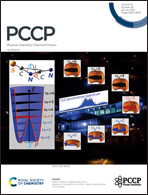Effect of fluoro and hydroxy analogies of diglyme on sodium-ion storage in graphite: a computational study†
Abstract
Diglyme co-intercalation with sodium ion (Na+) into graphite can enable the use of graphite as a potential anode for sodium-ion batteries (NIBs). However, the presence of diglyme molecules in Na+ intercalated graphite limits Na+ storage capacity and increases volume changes. In this work, the effect of functionalising diglyme molecules with fluoro and hydroxy groups on Na+ storage properties in graphite were computationally studied. It was found that the functionalisation can significantly alter the binding between sodium and the solvent ligand as well as between the sodium-solvent complex and the graphite. The hydroxy-functionalised diglyme exhibits the strongest binding to the graphite of the other functionalised diglyme compounds considered. The calculations also reveal that the graphene layer affects the electron distribution on the diglyme molecule and Na, so the diglyme complexed Na binds more strongly to the graphene layer than the Na alone. We also propose a mechanism for the early stages of the intercalation mechanism that involves a reorientation of the sodium–diglyme complex and suggest how the solvent can be designed to optimise the co-intercalation process.

- This article is part of the themed collection: Showcasing Physical Chemistry research in Australia and New Zealand


 Please wait while we load your content...
Please wait while we load your content...